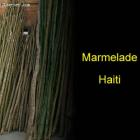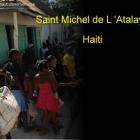ADVERTISEMENT
Earthquake - Haiti Observer Blog
Earthquake, Haiti Observer Blog. Read the following articles about Earthquake
How Haiti Earthquake of 1770, anthrax outbreak and the Haitian revolution are related
In 1770, Haiti's capital Port-au-Prince was struck by an earthquake. The political and social institutions of those times were completely shocked and blundered by the earthquake. Taking advantage of the destruction, majority of the slaves managed to escape, leading to further chaos. The stability of the country was lost and it went on to prove that Haiti then depended on its slaves for its stability. Even more disturbing was the fact that immediately after the earthquake, a mysterious plague claimed the lives of 15,000 people in Haiti.
The escaped slaves were responsible for harvesting and cooking and in their absence, the country was starving. Hiding in the countryside, the slaves even managed to cut off the supply of wild food, worsening the situation even more for the city-dwellers. As a result people purchased meat from Spanish merchants. These merchants failed to sell these meat in Spain. Soon there was an outbreak and people started falling sick with blackened lesions that were painful and eventually led to death. Back then, people could not figure out what caused this. Some thought it to be smallpox while epidemiologist Noah Webster called it Black Death.
List of Earthquakes in Haiti in recent years
Haiti has experienced a number of earthquakes. Here is a quick list in reverse order:
2010: Epicenter - 25km west of capital Port-au-Prince and magnitude of 7.0 Mw. Killed 316,000 people and injured 300,000.
1946 Dominican Republic: Earthquake of magnitude 8.0 in neighboring country shook Haiti very badly and triggered a tsunami killing 1,600 peole.
1842 Cap-Haitien: Magnitude of 8.1 killing 10,000 people in Cap-Haitien.
1783: A strong quake destroying Santiago church partially.
Where did the money collected for Haiti Earthquake go?
After the 2010 earthquake that shook Haiti and brought it down to rubbles, $13 billion was pledge by philanthropists, international institutions and foreign governments. Yet another $9 + billion funds were collected in private and public donations for reconstruction of Haiti or humanitarian aid. That sounds impressive but unfortunately, other than serving the construction of Korean sweatshops and luxury hotels for the foreigners, the collected $22+ billion aid barely left any footprints in Haiti.
Thousands and thousands of Haitians still live in tents and hunger is playing is dirty game while clean water is luxury commodity that can be accessed by only a handful. It was found that 94% of the aid money collected eventually ended up with the civilian and military entities of the donors, which include international NGOs, private contractors and U.N. Agencies. The Haitian government received barely 1% of the relief funds accumulated.
Prostitution in Haiti
There is a propensity to blame the rise of the most vice-like aspects of Haiti's current culture on the January 12, 2010 earthquake. Prostitution is one such vice often named consequence of the earthquake. The truth is, prostitution had already been a problem in the country, but had been quickly exacerbated by the loss of life and livelihood that the catastrophe caused.
Many children were left without parents after the earthquake. Not only did this rob them of their main source of sustenance, but they also suffered the loss of much needed guidance and the hope and insouciance to be gained from having parents to fend for them.
Institution du Sacre-Coeur Turgeau - Les Filles de la Sagesse
It has been a slow but eventual road to recovery for the sisters and students of the Institution du Sacré-Coeur de Turgeau. Ever since the January 2010 earthquake, which, in less than a minute, took down the old Sacred Heart in its entirety save for the gymnasium, the rebuilding process has been in progress. Now, the school can celebrate its brand new infrastructure, including the secondary school completed last year--with plans for three other modules to follow--, but there were many steps along the way to the restoration of the Institute of the Sacred-Heart.
Rene Preval and the 2010 Earthquake
When the largest earthquake ever recorded in this part of the Caribbean, a 7.0 magnitude behemoth that created more devastation than any other quake in the past 200 years of Haiti's history, struck, President René Préval was, like most Haitians on the January 2010 evening, hoping for a prosperous end to their day. Just before 5pm the earthquake struck and hours later, the death toll was astronomical, the devastation of local aid facilities almost total and the need for leadership paramount.
Criticized for the lack of representation some feel they experienced after the earthquake, Rene Preval made few statement to the press directly following the catastrophe. One such comment, to the Miami Herald, was filled with generalized reports of the devastation with him stating, 'There are a lot of schools that have a lot of dead people in them', and his estimation that thousands had perished.
An earthquake reminder for Haiti, Yesterday Evening with 3.5 shake
The population of the city of Thomazeau was very nervous yesterday evening (2/25/13) following an earthquake that took place there around 7:39:04 pm local time. The earthquake measured 3,5 on the open Richter scale and its epicenter was located 6 km northwest of the city of Thomazeau.
Residents in several nearby towns felt the shake and were terrified. This includes people in the metropolitan area of Port-au-Prince, Delmas, Martissant and Petion-ville. It has not been possible to make an estimate of damage caused by the shock. Many have reported no damage
Insurance to Sell Disaster Coverage in Haiti
Haiti is subject to catastrophic earthquakes, violent hurricanes, and deluges of rain on an intermittent basis.
The amount of damage done by these natural disasters adds up to hundreds of millions of dollars. While in the U.S., a significant number of the population carries disaster insurance, in Haiti its population of 10 million carries virtually none. Data collected shows only 0.3 percent insured against disaster occurrences. To address the financial loss the island experiences every time a natural disaster hits, two agencies have proposed solutions.
The International Finance Corporation, division of the World Bank, is launching a $1.96 million initiative to insure 70,000 small business owners without adequate disaster coverage. Without insurance, business owners can't pay their accounts, because losses have devoured whatever capital left. And a low credit rating disqualifies them for loans necessary to get their businesses operating again.
Milot, home of Sans Souci Palace
One of the Nord Department's municipalities is one of the most popular sites in the northern area of Haiti. Milot is a leading tourist attraction of the country, housing several historical landmarks and sites and having a rich history.
Milot is 20 kilometres from Cap-Haitien, a popular coastal city in the northern part of Haiti. In the 1800s, it was proclaimed as the country's first site capital by King Henri Christophe. Under King Henri I's rule, the beautiful Sans-Souci Palace was constructed from 1810 to 1813. The construction also included the building of eight smaller palaces, fifteen chateaus, several forts and summer homes, as well as twenty plantations, all owned and managed by the then royal family. The Palace is the notorious site of King Henri I's suicide in 1820. In 1842, it was destroyed by a strong earthquake and was never rebuilt. Despite its rough shape, it remains one of the most enamouring sites to see in Haiti, resulting in its designation as a UNESCO World Heritage Site in 1982.
Haitian Firms get One Percent of $1 Billion-Plus Reconstruction Funds
Center for Economic and Policy Research (CEPR) released a report that of $1.15 billion donated to Haiti post the earthquake, only one percent was received by Haitian firms, $1.15 million. The bulk of pledges was delivered to American-based corporations.
CEPR says it's impossible to find out where all the monies went. The problem is not who the main beneficiaries are, but where they are administering funds. For example, how much is spent on capital expenditures, administrative costs, transportation, and living allowances? And what amount has gone to Haiti's infrastructure?
United States Inter-Agency Development (USAID) organization, global disburser of monies, has refused comment on improprieties CEPR's report has hinted at. It has not offered any explanation why Haitian firms have received such a small share of funding, while Chemonics International Inc. (CII) has disproportionately been given $680 million in the last year. CII is the biggest beneficiary of USAID monies globally. Its $196-million share over the last three years outstrips combined totals of the second, third, and fourth beneficiaries on the disbursement list.
Our objective is to share with you news and information about Haiti and the people of Haiti. Traditions, habits and the way we were or grew are alive in this site. We highly recommend that you Subscribe to our Newsletter and also share with us some of the things that are memorable and made us unique people.

 Black Friday Shopping Season
Black Friday Shopping Season  Marmelade, Haiti
Marmelade, Haiti  Saint Michel de L 'Atalaye
Saint Michel de L 'Atalaye  Battle of Vertieres
Battle of Vertieres  Haitians are a Proud People
Haitians are a Proud People